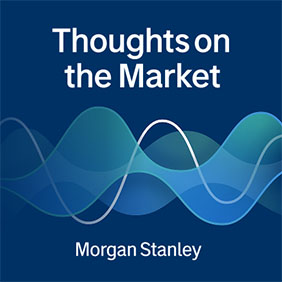An Unprecedented Wave of Inheritances Is Coming
October 10, 2025
Our U.S. Thematic and Equity Strategist Michelle Weaver discusses how the largest intergenerational wealth transfer in history could reshape saving, spending and investment behavior across America.

Thoughts on the Market
Listen to our financial podcast, featuring perspectives from leaders within Morgan Stanley and their perspectives on the forces shaping markets today.

Up Next
Lessons From a Bond Issued 90 Years Ago
Transcript
Andrew Sheets: Welcome to Thoughts on the Market. I'm Andrew Sheets, Head of Corporate Credit Research at Morgan Stanley.
Today, a look at the first bond that Morgan Stanley helped issue 90 years ago and what it might tell us about market uncertainty.
It's Thursday, October 9th at 4pm in London.
In times of uncertainty, it's common to turn to history. And this we think also applies to financial markets. The Great Depression began roughly 95 years ago. Of its many causes, one was that the same banks that were shepherding customer deposits were also involved in much riskier and more volatile financial market activity.
And so, when the stock market crashed, falling over 40 percent in 1929, and ultimately 86 percent from a peak to a trough in 1932, unsuspecting depositors often found their banks overwhelmed by this market maelstrom.
The Roosevelt administration took office in March of 1933 and set about trying to pick up the pieces. Many core aspects that we associate with modern financial life from FDIC insurance to social security to the somewhat unique American 30-year mortgage rose directly out of policies from this administration and the financial ashes of this period.
There was also quite understandably, a desire to make banking safer. And so the Glass Steagall Act mandated that banks had a choice. They could either do the traditional deposit taking and lending, or they could be active in financial market trading and underwriting. In response to these new separations, Morgan Stanley was founded 90 years ago in 1935 to do the latter.
It was a very uncertain time. The U.S. economy was starting to recover under President Roosevelt's New Deal policies, but unemployment was still over 17 percent. Europe's economy was struggling, and the start of the Second World War would be only four years away. The S&P Composite Equity Index, which currently sits at a level of around 6,700, was at 12.
It was into this world that Morgan Stanley brought its first bond deal, a 30-year corporate bond for a AA rated U.S. utility. And so, listeners, what do you think that that sort of bond yielded all those years ago?
Luckily for us, the good people at the Federal Reserve Bank of St. Louis digitized a vast array of old financial newspapers. And so, we can see what the original bond yielded in the announcement. The first bond, Morgan Stanley helped issue with a 30-year maturity and a AA rating had a yield of just 3.55 percent. That was just 70 basis points over what a comparable U.S. treasury bond offered at the time.
Anniversaries are nice to celebrate, but we think this example has some lessons for the modern day. Above anything, it's a clear data point that even in very uncertain economic times, high quality corporate bonds can trade at very low spreads – much lower than one might intuitively expect.
Indeed, the extra spread over government bonds that investors required for a 30-year AA rated utility bond 90 years ago, in the immediate aftermath of the Great Depression is almost exactly the same as today.
It's one more reason why we think we have to be quite judicious about turning too negative on corporate credit too early, even if the headline spreads look low.
Thank you as always for your time. If you find Thoughts on the Market useful, let us know by leaving a review wherever you listen. And also, please tell a friend or colleague about us today.

When Will the Shutdown Affect Markets?
Transcript
Welcome to Thoughts on the Market. I'm Michael Zezas, Global Head of Fixed Income Research and Public Policy Strategy.
Today: Three checkpoints we’re watching for as the U.S. government shutdown continues.
It’s Wednesday, October 8th at 10:30am in New York.
The federal government shutdown in the United States has crossed the one week mark. But if you’re watching the markets, you might be surprised at how calm everything seems. Stocks are steady. Bond yields haven’t moved much, and volatility’s low.
It’s more or less the scenario my colleague Ariana and I had talked about in anticipation of the impasse in Washington. We’d noted the potential for uncertainty for investors and market reaction depending on how long the shutdown would last.
So that raises a big question: what, if anything, about this government shutdown could shake investor confidence and start moving markets?
The question is worth considering. Prediction markets now suggest the most likely outcome is that the government shutdown will not end for at least another week. And as we’ve seen in past shutdowns, the longer it drags on, the more likely it is to matter. That’s because risks to the economic outlook start to accumulate, and investors eventually have to start pricing in a weaker growth outlook.
There’s a few checkpoints we’re watching for – for when investors might start feeling this way.
First, the missed paycheck for furloughed federal workers. The first instance of this comes in a few days. Less pay naturally means less spending. Studies suggest that spending among affected workers can drop by two to four percent during a shutdown. That’s not huge for GDP at first — but it’s a sign the shutdown is having effects beyond Washington, DC.
Second, this time might be different because of potential layoffs. The administration has hinted that agencies could move to permanently cut staff — something we haven’t seen before. Unions have already said they’d challenge that in court. But if those actions start, or even if legal uncertainty grows around them, it could raise the economic stakes.
Third, we’re watching for real disruptions to economic activity resulting from the shutdown. The last shutdown ended when air traffic in New York was curtailed due to a shortage of air traffic controllers. We’re already seeing substantial air traffic delays across the country. More substantial delays or ground halts obviously impede economic activity related to travel. And if such actions don’t coincide with signals from DC of progress in negotiating a bill to reopen the government, investors’ concern could grow.
So here’s the bottom line: markets may be right to stay calm — for now. But the longer this shutdown lasts, the more likely one of these pressure points pushes investors to rethink their optimism.
Thanks for listening. If you enjoy Thoughts on the Market, please leave us a review and tell your friends about the podcast. We want everyone to listen.

Sign up to get Morgan Stanley Ideas delivered to your inbox.
Thank You for Subscribing!
Would you like to help us improve our coverage of topics that might interest you? Tell us about yourself.



